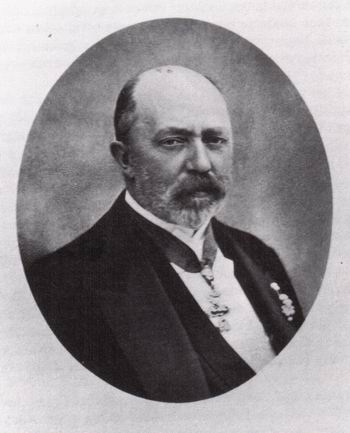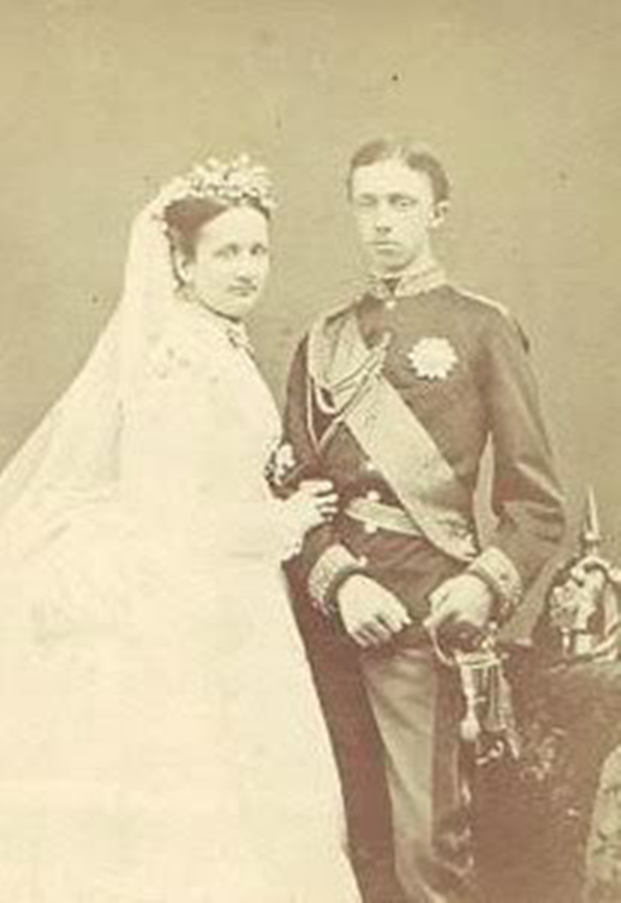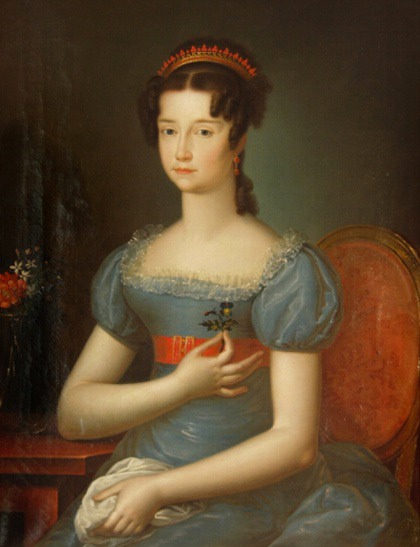by Susan Flantzer
© Unofficial Royalty 2021
The Duchy of Parma was in today’s northwest Italy and came into existence in 1545 when Pope Paul III made his illegitimate son Pier Luigi Farnese the Duke of Parma and Piacenza, territories that previously were a part of the Papal States. The House of Farnese reigned until 1731 when the male line went extinct. The duchy passed to Felipe V, King of Spain from the Spanish House of Bourbon whose second wife Elizabeth Farnese was the Farnese heiress. Felipe V made Carlos, his only son with Elizabeth Farnese, the Duke of Parma. However, in 1738, Felipe V traded the Duchy of Parma to the House of Habsburg-Lorraine for the Kingdom of Naples and Sicily and Carlos became King of Naples and Sicily.
In 1748, the Duchy of Parma was ceded back to the Bourbons. Infante Felipe of Spain became Duke of Parma and was the founder of the House of Bourbon-Parma, a cadet branch of the Spanish House of Bourbon. In 1796, the Duchy of Parma was occupied by French troops under Napoleon Bonaparte. It remained in French hands until the defeat of Napoleon in 1814 when the duchy was given to Napoleon’s second wife, Marie-Louise of Habsburg-Lorraine. She reigned until her death in 1847 when the Duchy of Parma was restored to the House of Bourbon-Parma. In 1859, the Duchy of Parma was abolished during the Italian unification movement. It was merged with the Kingdom of Sardinia as part of the unification of Italy. In 1861, Vittorio Emanuele II, King of Sardinia was proclaimed the first King of the new, united Kingdom of Italy.
********************

Louise Marie Thérèse of France, Duchess of Parma, Regent of Parma; Credit – Wikipedia
Louise Marie Thérèse of France was the wife of Carlos III, Duke of Parma and Regent for their son Roberto I, Duke of Parma until the Duchy of Parma was abolished during the Italian unification movement. Louise Marie Thérèse was born on September 21, 1819, at the Élysée Palace in Paris, France. She was the third of the four children and the second of the two daughters of Prince Charles Ferdinand of France, Duke of Berry and Princess Maria Carolina of Bourbon-Two Sicilies. Louise Marie Thérèse’s paternal grandparents were King Charles X of France (grandson of King Louis XV and brother of King Louis XVI) and Princess Maria Theresa of Savoy. Her maternal grandparents were King Francesco I of the Two Sicilies and his first wife Maria Clementina of Austria.

Louise Marie Thérèse with her brother younger brother Henri and her mother Maria Carolina of Bourbon-Two Sicilies; Credit – Wikipedia
Louise Marie Thérèse had three siblings but her two eldest siblings died soon after birth:
The House of Bourbon was restored to the French throne in the aftermath of Napoléon I’s defeat and final exile and reigned from 1815 to 1830. The two kings who reigned during the Bourbon Restoration, Louis XVIII and Charles X, were younger brothers of the guillotined King Louis XVI.

Maria Carolina, Duchess of Berry in mourning for her husband with her two children, Louise Marie Thérèse’ and Henri; Credit – Wikipedia
Five months after her birth, on February 13, 1820, Louise Marie Thérèse’s father Charles Ferdinand, Duke of Berry was stabbed while leaving the opera house in Paris with his wife and died the next day. The assassin was a saddlemaker named Louis Pierre Louvel, a Bonapartist who wanted to end the House of Bourbon. At the time of his death, Charles Ferdinand’s childless uncle Louis XVIII was the King of France, and his father, the future King Charles X was the heir to the throne. Charles Ferdinand was third in the Bourbon line of succession to the French throne after his childless elder brother Louis Antoine, Duke of Angoulême. Louise Marie Therese’s mother was pregnant and gave birth to a son seven months later who became the third in the line of succession.

Louise Marie Thérèse in 1830; Credit – Wikipedia
As a child, Louise Marie Thérèse lived at her birthplace, the Elysée Palace in Paris. and Château de Rosny-sur-Seine, her mother’s main residence, just a short distance from Paris. Marie-Joséphine Louise de Montaut-Navailles, Marquise de Gontaut Saint-Blacard, a former lady-in-waiting to Louise Marie Thérèse’s mother was appointed the governess to Louise Marie Thérèse and her brother Henri and was responsible for their education.

The French Royal Family in 1823 – left to right: Marie-Thérèse, Duchess of Angoulême; Louis-Antoine, Duke of Angoulême; Prince Henri; Charles-Philippe, Count of Artois (future King Charles X); King Louis XVIII of France; Princess Louise Marie Thérèse; Marie-Caroline, Duchess of Berry; Credit – Wikipedia
Louise Marie Thérèse’s grandfather King Charles X of France succeeded to the throne upon the death of his brother King Louis XVIII of France in 1824. He would prove to be very unpopular with the French people, and would not remain on the throne for very long. When he issued very restrictive ordinances, in July 1830, there were quick calls for revolution, now called the July Revolution of 1830. When rioting began, Charles X’s government ministers pleaded with him to revoke the ordinances but he refused. By the end of the night, the members of the Chamber of Deputies had decided that Charles X must go and that Louis-Philippe III, Duke of Orléans, a descendant of Philippe I, Duke Orléans, the brother of King Louis XIV of France, would become Louis-Philippe, King of the French.
Maria Caroline, Duchess of Berry and her two children Louise Marie Thérèse and Henri joined the rest of the French Bourbons in exile in the United Kingdom. Initially, Maria Carolina and her children lived in Bath but then they moved to Edinburgh, Scotland to be closer to the former king, Charles X, who was living at Holyrood Palace. Maria Carolina did not like living in Edinburgh agreeable, nor did she like the exclusion of her son Henri from the French throne by Louis Philippe, King of the French. She declared her son Henri to be the legitimate king, and herself to be regent. In 1831, she left Edinburgh and returned to her family in Naples.

Louise Marie Thérèse’s guardian Marie-Thérèse-Charlotte, Duchess of Angoulême; Credit – Wikipedia
On December 14, 1831, Maria Carolina secretly married an Italian nobleman, Ettore Carlo Lucchesi-Palli, 8th Duca della Grazia. After the scandal of her secret morganatic marriage, the subsequent birth of a child in 1833, and an abortive insurrection to put her son on the French throne, Maria Carolina lost all her prestige. Marie-Thérèse-Charlotte, Duchess of Angoulême, the only surviving child of the guillotined King Louis XVI of France, who had married her first cousin and Louise Marie Thérèse’s paternal uncle, Louis Antoine of France, Duke of Angoulême became the guardian of Louise Marie Thérèse and her brother Henri:
Louise Marie Thérèse had six half-siblings from her mother’s second marriage to Ettore Carlo Lucchesi-Palli, 8th Duca della Grazia:
- Anna Maria Rosalia Lucchesi-Palli (born and died 1833)
- Maria Bianca Lucchesi Palli (born and died 1834)
- Clementina Lucchesi-Palli (1835 – 1925), married Count Camillo Zileri dal Verme degli Obbizi;
- Francesca di Paola Lucchesi-Palli (1836 – 1923) married Camillo Massimo, Prince of Arsoli
- Maria Isabella Lucchesi-Palli (1838 – 1873), married (1) Massimiliano dei Marquis Cavriani (2) Count Giovanni Battista de Conti
- Adinolfo Lucchesi-Palli, Duke of Grace (1840 – 1911), married Lucrezia Nicoletta Ruffo di Bagnara

Carlos III, Duke of Parma, Louise Marie Thérèse’s husband; Credit – Wikipedia
When it came time to arrange a marriage for Louise Marie Thérèse, her guardian and aunt Marie-Thérèse-Charlotte, Duchess of Angoulême rejected several marriage proposals and was adamant that Louise Marie Thérèse should marry a Bourbon. There were few Bourbon princes to choose from and by the time she reached the age of twenty-five Louise Marie Thérèse was still unmarried. Finally, in 1845, a marriage was arranged. The groom was the future Carlo III, Duke of Parma from the House of Bourbon-Parma, a cadet branch of the Spanish House of Bourbon, originally a branch of the French House of Bourbon. His father Carlo II Ludovico, Duke of Parma was in financial difficulty and decided to marry his son to a princess with a large dowry. Carlo was four years younger than Louise Marie Thérèse and they had first met as children. They were married on November 10, 1845, at Schloss Frohsdorf in Lanzenkirchen in Austria, the home in exile of the bride’s aunt by marriage and guardian Marie-Thérèse-Charlotte, Duchess of Angoulême.

Louise Marie Thérèse and her four children in 1860. Left to right: Roberto, Louise Marie Thérèse, Margherita, Enrico, and Alice: Credit – Wikipedia
Carlo and Louise Marie Thérèse had four children:
- Princess Margherita of Bourbon-Parma (1847 – 1893), married Infante Carlos, Duke of Madrid, had five children
- Roberto I, Duke of Parma (1848 – 1907), married (1) Princess Maria Pia of Bourbon-Two Sicilies, had twelve children including Princess Maria Luisa who married Tsar Ferdinand I of Bulgaria (2) Infanta Maria Antonia of Portugal, had twelve children including Princess Zita who married, Karl I, the last Emperor of Austria and Prince Felix who married Grand Duchess Charlotte of Luxembourg
- Princess Alice of Bourbon-Parma (1849 – 1935), married Ferdinando IV, Grand Duke of Tuscany, had ten children
- Prince Enrico, Count of Bardi (1851 – 1905), married (1) Princess Maria Luisa of Bourbon-Two Sicilies, died three months after marriage (2) Infanta Adelgundes of Portugal, Duchess of Guimarães, no children
In December 1847, Napoleon’s second wife Marie-Louise of Austria, reigning Duchess of Parma died. As stipulated by the 1815 Congress of Vienna, the Duchy of Parma was restored to the House of Bourbon-Parma and Carlo’s father became Carlo II Ludovico, Duke of Parma. However, the reign of Carlo II Ludovico, Duke of Parma was short. He was very unpopular with the citizens of Parma, and within a few months, he was ousted by a revolution. Carlo II Ludovico regained control of Parma with the help of Austrian troops but finally abdicated in favor of his son Carlo III, Duke of Parma on March 14, 1849.
The authoritarian policies of Carlo III, Duke of Parma made him unpopular. He placed Parma under martial law, inflicted heavy penalties on the members of the former provisional government, closed the university, and instituted persecution policies. Plots to remove Carlo III from power began to circulate in 1853. His personal life was also in trouble. Carlo had separated from Louise Marie Thérèse who had become obese, and began an open affair with Countess Emma Guadagni. The marriage of Carlo and Louise Marie Thérèse became completely irreconcilable when Carlo took his mistress on a semi-official visit to Queen Isabella II of Spain in December 1853.
On March 26, 1854, while taking his usual afternoon walk through the streets of Parma, Carlo III was attacked by two men who stabbed him in the stomach. After much suffering, which he endured bravely, thirty-one-year-old Carlo III, Duke of Parma died the following evening, March 27, 1854. Ireneo Bochi and Antonio Carra, Carlo’s murderers, escaped prosecution. They were briefly arrested but since they looked similar, witnesses were confused and deemed unreliable. Bochi and Carra did not act for political reasons but were hired killers. However, who paid them remains unknown.

Louise Marie Therese, Regent of Parma with her son Roberto I, Duke of Parma; Credit – Wikipedia
Carlo III’s six-year-old son Roberto became Duke of Parma with Louise Marie Thérèse as regent but had a short reign. In 1859, the Duchy of Parma was abolished during the Italian unification movement. It was merged with the Kingdom of Sardinia as part of the unification of Italy. In 1861, Vittorio Emanuele II, King of Sardinia was proclaimed the first King of the new, united Kingdom of Italy.

The crypt with the tombs of King Charles X of France and other members of the former French royal family; Credit – By Viator slovenicus – Own work, CC BY-SA 3.0, https://commons.wikimedia.org/w/index.php?curid=7164631
Louise Marie Thérèse took her children to Venice, Kingdom of Lombardy-Venetia, now in Italy where she spent the rest of her life in exile. She survived her husband by ten years, dying on February 1, 1864, at the age of 44, at the Palazzo Giustinian in Venice. She was buried in the crypt of her grandfather King Charles X of France at the Kostanjevica Monastery in what is now Pristava, Slovenia. Other members of the former French royal family buried there include her brother Henri, Count of Chambord, and her uncle and aunt Louis Antoine and Marie-Thérèse-Charlotte, Duke and Duchess of Angoulême.
This article is the intellectual property of Unofficial Royalty and is NOT TO BE COPIED, EDITED, OR POSTED IN ANY FORM ON ANOTHER WEBSITE under any circumstances. It is permissible to use a link that directs to Unofficial Royalty.
Works Cited
- Almanachdegotha.org. 2021. Duchy of Parma – House of Bourbon-Parma. [online] Available at: <http://www.almanachdegotha.org/id29.html> [Accessed 11 October 2021].
- En.wikipedia.org. 2021. Marie-Caroline of Bourbon-Two Sicilies, Duchess of Berry – Wikipedia. [online] Available at: <https://en.wikipedia.org/wiki/Princess_Marie_Caroline_of_Naples_and_Sicily> [Accessed 16 October 2021].
- En.wikipedia.org. 2021. Princess Louise d’Artois – Wikipedia. [online] Available at: <https://en.wikipedia.org/wiki/Princess_Louise_d%27Artois> [Accessed 16 October 2021].
- Flantzer, Susan, 2021. Carlo III, Duke of Parma. [online] Unofficial Royalty. Available at: <https://www.unofficialroyalty.com/carlo-iii-duke-of-parma/> [Accessed 16 October 2021].
- It.wikipedia.org. 2021. Luisa Maria di Borbone-Francia (1819-1864) – Wikipedia. [online] Available at: <https://it.wikipedia.org/wiki/Luisa_Maria_di_Borbone-Francia_(1819-1864)> [Accessed 16 October 2021].
- Louda, Jiri and MacLagan, Michael, 2002. Lines of Succession. New York: Barnes and Noble.
- Mehl, Scott, 2016. King Charles X of France. [online] Unofficial Royalty. Available at: <https://www.unofficialroyalty.com/king-charles-x-of-france/> [Accessed 16 October 2021].














































